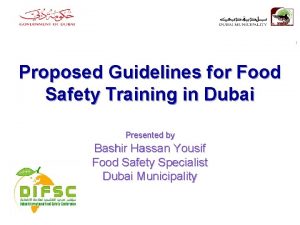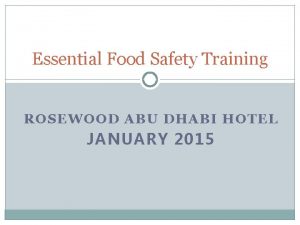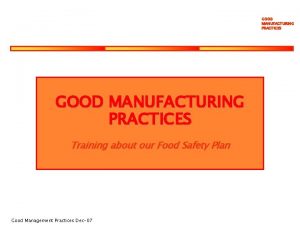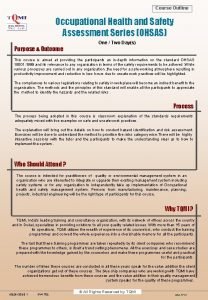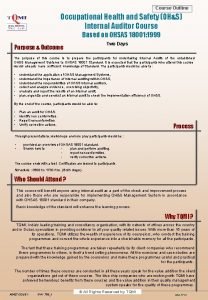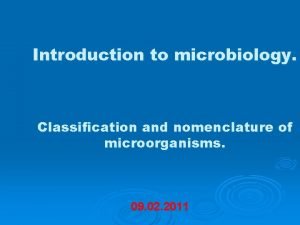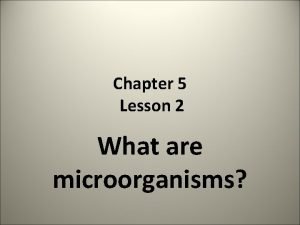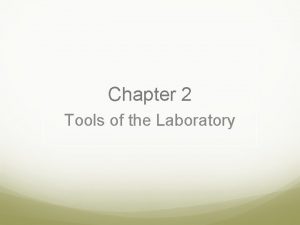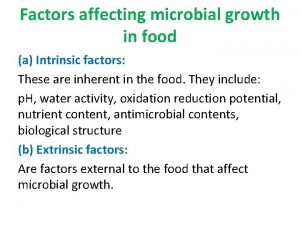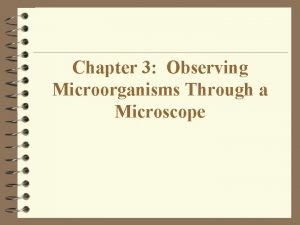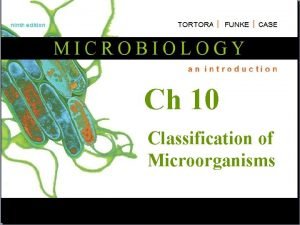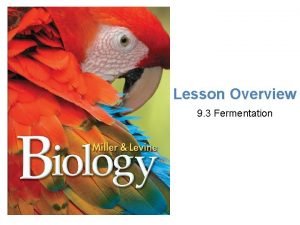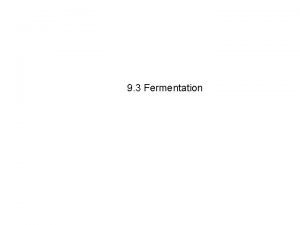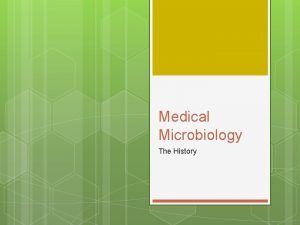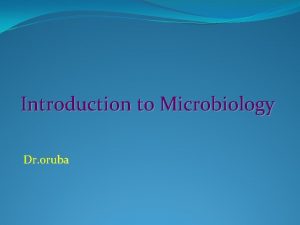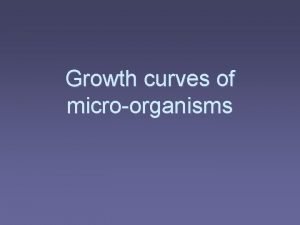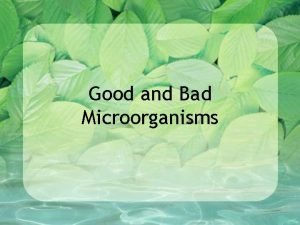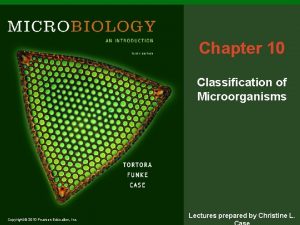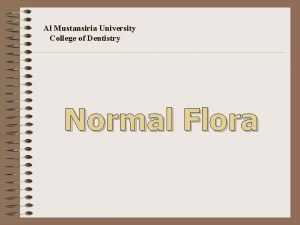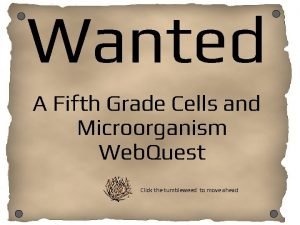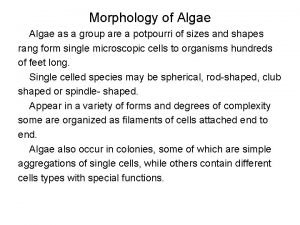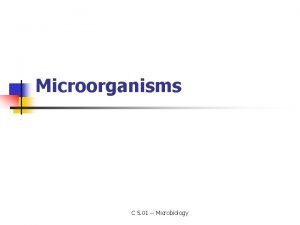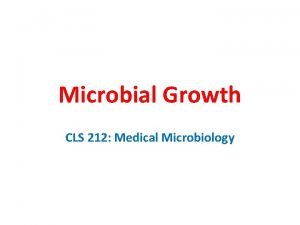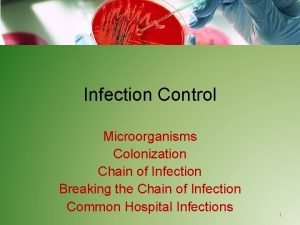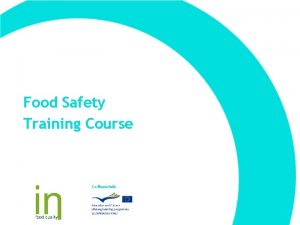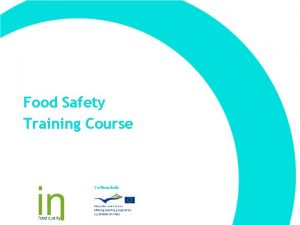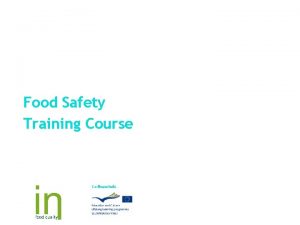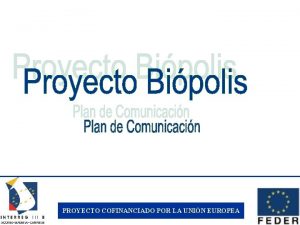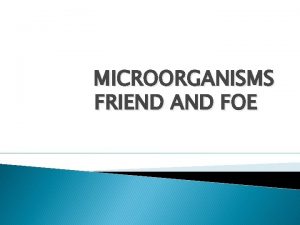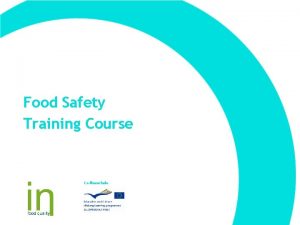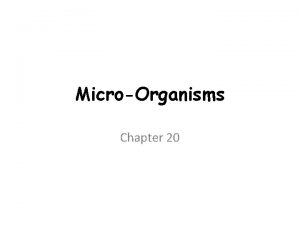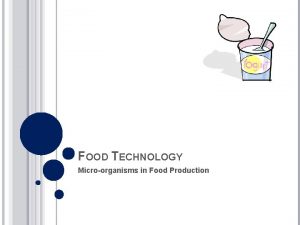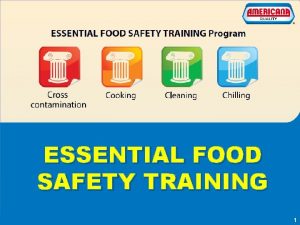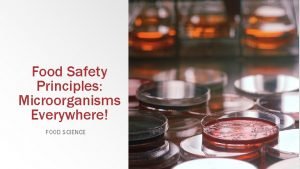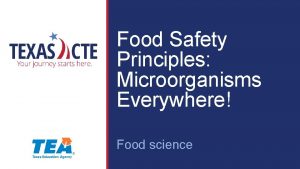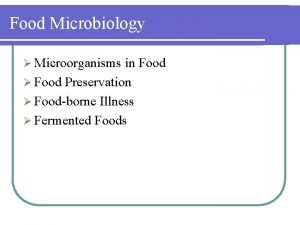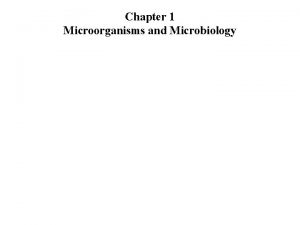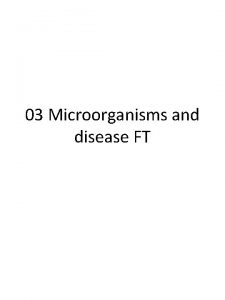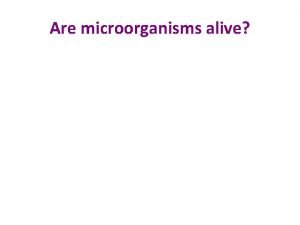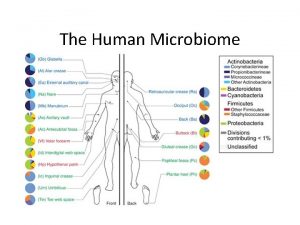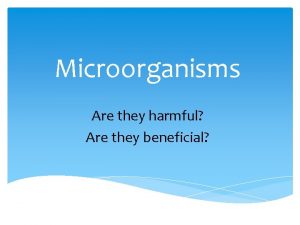Food safety Training Course Cofinanciado Microorganisms and food
































- Slides: 32

Food safety Training Course Co-financiado:

Microorganisms and food intoxications

3| 32 Microorganisms and food Intoxications Microorganisms • What are they? • Main characteristics of living beings? • Functions and applications?

4| 32 Microorganisms and food Intoxications Microbial Growth • What do you understand by microbial growth? • What factors affect microbial growth? • How can we control the growth?

5| 32 Microorganisms and food Intoxications Microbial Growth in optimum conditions Growth in other situations Time Microbial growing stages in a liquid environment. A – Lag stage; B- log stage; Cstationary stage and D- death stage

6| 32 Microorganisms and food Intoxications Microbial Growth • Intrinsic factors? • Extrinsic factors? • Other factors: - Biological structures - Natural antimicrobial substances

7| 32 Microorganisms and food Intoxications Microbial growth Table I – p. H level interval for the growth of some microorganisms Minimum p. H Optimum p. H Maximum p. H Mold 1, 5 to 3, 5 4, 5 to 6, 8 8 to 11 Yeast 1, 5 to 3, 5 4 to 6, 5 8 to 8, 5 Bacteria (most) 4, 5 to 5, 5 6, 5 to 7, 5 8, 5 to 9 Lactic Bacteria 3 to 5 5, 5 to 7, 5 6, 5 to 8 Data: Jay, J. M. , 1996

8| 32 Microorganisms and food Intoxications Microbial Growth Table II - Approximate p. H levels of some food products Product Egg whites p. H 7, 5 to 9 Egg yolk 6, 1 Shellfish Product Corn p. H 7 to 7, 5 Potatoes 5, 3 to 5, 6 6, 8 to 8, 2 Carrots 5, 2 to 6, 2 Fish (most) 6, 3 to 6, 8 Onion 5, 3 to 5, 8 Fresh milk 6, 3 to 6, 5 Tomatoes 4, 2 to 5, 8 Butter 6, 1 to 6, 4 Oranges 3, 6 to 4, 3 Chicken 6, 2 to 6, 4 Grapes 3, 4 to 4, 5 Pork 5, 3 to 6, 4 Apples 2, 9 to 3, 3 Beef Dados de : Jay, J. M. , 1996 5, 1 to 6, 2 Lemons 1, 8 to 2, 4

9| 32 Microorganisms and food Intoxications Microbial growth • Extrinsic factors Temperature is one of the most relevant factors for microbial growth.

10| 32 Microorganisms and food Intoxications Microbial growth Hours Boiling point Freezing Data: Jay, J. , 1996. N. º of bacteria

11| 32 Microorganisms and food Intoxications Microbial growth • Utilization of risk temperatures while conserving food/meals; • Utilization of inadequate temperatures while preparing/processing those foods (under processing); These are the two main causes that lead to Intoxications :

12| 32 Microorganisms and food Intoxications Microbial growth factors – Hurdle effect Adapted from: Adams, M. R. and Moss, M. O. , 1995

13| 32 Microorganisms and food Intoxications Microorganisms • Main groups with importance for FS: – Bacteria • Main characteristics – Fungi (Molds and yeasts) • Main characteristics

14| 32 Microorganisms and food Intoxications Bacteria Photos: www. denniskunkel. com

15| 32 Microorganisms and food Intoxications Fungi • • • Unicellular (yeasts); Multicellular (molds or filamentous fungi); Great decomposers of organic matter; Widely used for making food and beverages; Some are eatable (mushrooms); Responsible for deteriorating most fruits and vegetables.

16| 32 Microorganisms and food Intoxications Molds and yeasts Some utilizations of fungi: a) Some eatable mushrooms. b) beer ; c) bread; d) Roquefort cheese with blue mold; e) e f) Camembert an brie cheeses (respectively) with white mold.

17| 32 Microorganisms and food Intoxications Molds and yeasts Mold on food

18| 32 Microorganisms and food Intoxications Main sources • What are the sources of microorganisms that are present on foods? – Soil; – Water; – Air; – Handlers; – Utensils and equipments; – Products themselves or raw materials used in their fabrication.

19| 32 Microorganisms and food Intoxications Main sources • Soil - Source of spore forming bacteria, fungi and yeasts; - Addition of manure – faecal microorganisms; - Dissemination of microorganisms: wind, rain, animals, fertilization…

20| 32 Microorganisms and food Intoxications Main sources What measures should be taken to avoid/reduce contamination? Table III – Effect of washing on the flora of vegetable products Type of product Tomato Collards Num. of microorganisms Not washed > 1 000/ cm 2 Washed 400 -700/cm 2 External leaves not washed 1 000 – 2 000/g Internal leaves washed 200 000 – 500 000/g Internal leaves 100 – 10 000/g Data: Jay, J. M. , 1996 e Lacasse, D. . 1995.

21| 32 Microorganisms and food Intoxications Main sources • Water - May contain various types of microorganisms (origin and level of pollution); - Utilization of potable water! How to avoid contamination?

22| 32 Microorganisms and food Intoxications Main sources • Air - Non favourable environment for microbial growth; - Excellent conveyer of microorganisms from other sources: sneezing, coughing, agricultural activities … How to reduce contamination caused by microorganisms transmitted by air?

23| 32 Microorganisms and food Intoxications Main sources • Food Diverse and proper flora : – Vegetables – Animals Intestines Soil Animals Water

24| 32 Microorganisms and food Intoxications Main sources • Handlers - Diverse and own flora (faecal matter and skin); - Main problems? • Utensils and Equipments - Do not have own microflora; - Main cause of CROSS CONTAMINATIONS!!!

25| 32 Microorganisms and food Intoxications Cross contamination • What is “cross contamination”? Microorganisms present in raw foods, utensils and contaminated surfaces are transferred to prepared or washed foods or to clean surfaces. . - What are the main conveyers? - How to prevent/avoid? - Examples

26| 32 Microorganisms and food Intoxications Risks and hazards • Difference between “Hazard” and “Risk” - What is the origin of hazards? - Examples

27| 32 Microorganisms and food Intoxications Risks and hazards Table IV – Classification of hazards related to food safety Types of hazards Microbiological Examples of hazards Examples of associated foods Potential illnesses Bacteria Salmonella Campylobacter Eggs, poultry, raw milk and milk products Raw milk, cheese, ice cream, salads Salmonellosis Campylobacteriosis Virus Rotavirus Hepatitis A virus Salads, fruit and appetizers Fish, seafood, vegetables, water, fruit, milk Diarrhoea Hepatitis A Parasites Toxoplasm Giardia Pork, yearling lamb Water, salads Toxoplasmosis Giardosis Prions BSE agent Specific bovine risk materials Variant of the Creutzfeldt-Jakob disease

28| 32 Microorganisms and food Intoxications Riscos e Perigos Table V – Classification of hazards related to food safety Types of hazards Chemical Examples of hazards Examples of associated foods Potential illnesses Natural toxins Aflotoxins Solanin Marine toxins Nuts, corn, milk and milk products Potato Shellfish, seafood Mercury, Cadmium and lead Dioxins, PCBs Fish, animal fat French fries, coffee, cookies, bread Smoked products, vegetable oils, grilled food Pollutants of industrial origin Contaminants that result from food processing Acrilamid Polycyclical aromatic hydrocarbons Pesticides Insecticides, herbicides, fungicides Vegetables, fruits fruit products Veterinary medicines Anabolics, antibiotics Poultry, pork, beef Non authorized additives Sudan I-IV, for red (dyes) Sauces, spices Material in contact with food Aluminium, plastic Canned or packaged food Other Cleaning products, lubrificants tin, and plastic Cancer, congenital malformations, premature births, alterations of the immune system; nervous system degenerative diseases; hormonal alterations, dysfunction of various organs; fertility alterations; muscle and bone diseases; behaviour alterations.

29| 32 Microorganisms and food Intoxications Riscos e Perigos Table VI – Classification of hazards related to food safety Types of hazards Examples of associated foods Physical Bones, fish bones, glass, metal, stones Nutritional Excess salt Table salt, snacks Cardiovascular diseases Excess fat Butter, fat meat Obesity lesions Excess sugar Allergens Potential illnesses Diabetes Cow milk, peanut, eggs, crustaceans Allergies

30| 32 Microorganisms and food Intoxications and main agents • What are the main factors that determine the occurrence of food intoxications? • What are the main agents? • What are the symptoms and characteristics of these illnesses? • What are the main foods related to food intoxications?

31| 32 Microorganisms and food Intoxications Table VI – Food and agents generally associated to foodborne intoxications and main agents Food Generally associated microorganisms Raw seafood Vibrio sp. , Hepatitis A virus, Norovirus (Norwalk-like viruses) Raw eggs Salmonella Undercooked meat Salmonella and Campylobacter, Escherichia coli STEC, Clostridium perfringens Unpasteurized juice milk or Salmonella, Campylobacter, Yersinia, STEC Unpasteurized soft cheese Salmonella, Campylobacter, Yersinia, Listeria sp. , STEC Homemade conserves Clostridium botulinum (botulism) Hotdogs, ham, etc. Listeria sp.

32| 32 Microorganisms and food Intoxications Table VIII – Characteristics of main foodborne Intoxications and main agents Microorganism Type of illness Campylobacter jejuni Infection Clostridium perfringes Intoxication Escherichia coli (various types: EPEC; EIEC; ETEC; and EHEC) Infection Salmonella spp. Infection Hepatitis A Infection *Bacillus cereus Clostridium botulinum Staphylococcus aureus Poisoning Symptoms Probable food Diarrhea, sometimes followed by fever; abdominal pain, nausea; headaches and muscle pain Raw poultry and other food contaminated by raw poultry, unpasteurized milk, untreated water Intense abdominal cramps; diarrhea Meat and meat products, sauces, products rich in protein Watery diarrhea, abdominal cramps, low fever, nausea, MAL ESTAR Contaminated water, undercooked minced meat, unpasteurized milk and juice; pieces of melon. Abdominal cramps, diarrhea, fever, headaches Animal based food; other food contaminated due to the contact with feces, raw animal based food or infected handlers. Poultry, eggs, raw milk and meat are often found contaminated. Fatigue, abdominal cramps, anorexia, intermittent nausea, diarrhea, vomiting Raw or under cooked seafood, food prepared by infected handlers Watery diarrhea, cramps Nausea and vomiting Cooked products left uncovered; milk, meat, vegetables, fish; rice and food rich in starch Lethargy, weakness, dizziness, double vision; difficulty talking, swallowing and/or breathing, paralysis, possible death Inadequate processing of homemade conserves; hotdogs, marine products, canned minced garlic; honey Nausea, vomiting, abdominal cramps Contaminated food due to inadequate handling and storage temperatures – meat and meat products; poultry and egg products; salads rich in proteins, sandwich fillings, pastry products with creams and fillings.
 Safety care behavioral safety training
Safety care behavioral safety training Flora fauna and microorganisms
Flora fauna and microorganisms Course title and course number
Course title and course number Food safety training in dubai
Food safety training in dubai Food safety training abu dhabi
Food safety training abu dhabi Gmp food safety training
Gmp food safety training Occupational health and safety course outline
Occupational health and safety course outline Occupational health and safety course outline
Occupational health and safety course outline Learning objectives of microorganisms
Learning objectives of microorganisms Microorganisms importance
Microorganisms importance Are microorganisms helpful or harmful
Are microorganisms helpful or harmful Harmful microorganisms
Harmful microorganisms The five i's of studying microorganisms
The five i's of studying microorganisms Factors affecting food spoilage
Factors affecting food spoilage Observing microorganisms through a microscope
Observing microorganisms through a microscope Microorganisms meaning
Microorganisms meaning Microorganisms 5th grade
Microorganisms 5th grade Fermentation in microorganisms
Fermentation in microorganisms Fermentation in microorganisms
Fermentation in microorganisms Bacteria wanted poster template
Bacteria wanted poster template What is microbiology
What is microbiology Classification of microorganisms
Classification of microorganisms Microorganisms
Microorganisms What is the microorganisms
What is the microorganisms Physiology of microorganisms
Physiology of microorganisms Gammaproteobacteria dichotomous key
Gammaproteobacteria dichotomous key What is the microorganisms
What is the microorganisms Wanted posters microorganisms
Wanted posters microorganisms Nutritional requirements of microorganisms
Nutritional requirements of microorganisms Major groups of microorganisms
Major groups of microorganisms Biogas microorganisms
Biogas microorganisms Factors affecting bacterial growth ppt
Factors affecting bacterial growth ppt Microorganism
Microorganism



